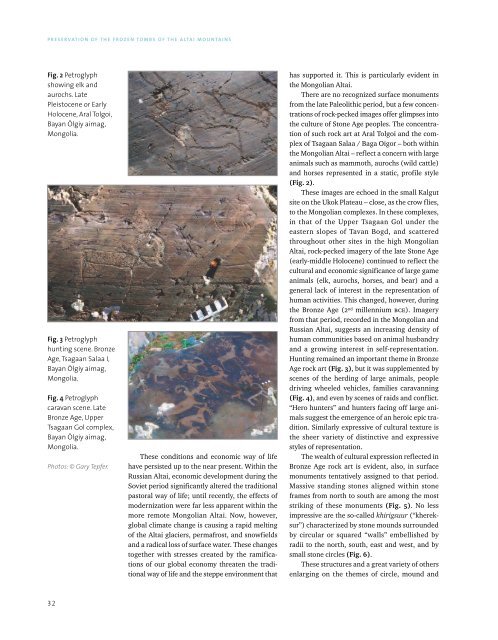Scythian Culture - Preservation of The Frozen Tombs of The Altai Mountains (UNESCO)
Create successful ePaper yourself
Turn your PDF publications into a flip-book with our unique Google optimized e-Paper software.
PRESERVATION OF THE FROZEN TOMBS OF THE ALTAI MOUNTAINS<br />
Fig. 2 Petroglyph<br />
showing elk and<br />
aurochs. Late<br />
Pleistocene or Early<br />
Holocene, Aral Tolgoi,<br />
Bayan Ölgiy aimag,<br />
Mongolia.<br />
Fig. 3 Petroglyph<br />
hunting scene. Bronze<br />
Age, Tsagaan Salaa I,<br />
Bayan Ölgiy aimag,<br />
Mongolia.<br />
Fig. 4 Petroglyph<br />
caravan scene. Late<br />
Bronze Age, Upper<br />
Tsagaan Gol complex,<br />
Bayan Ölgiy aimag,<br />
Mongolia.<br />
Photos: © Gary Tepfer.<br />
<strong>The</strong>se conditions and economic way <strong>of</strong> life<br />
have persisted up to the near present. Within the<br />
Russian <strong>Altai</strong>, economic development during the<br />
Soviet period significantly altered the traditional<br />
pastoral way <strong>of</strong> life; until recently, the effects <strong>of</strong><br />
modernization were far less apparent within the<br />
more remote Mongolian <strong>Altai</strong>. Now, however,<br />
global climate change is causing a rapid melting<br />
<strong>of</strong> the <strong>Altai</strong> glaciers, permafrost, and snowfields<br />
and a radical loss <strong>of</strong> surface water. <strong>The</strong>se changes<br />
together with stresses created by the ramifications<br />
<strong>of</strong> our global economy threaten the traditional<br />
way <strong>of</strong> life and the steppe environment that<br />
has supported it. This is particularly evident in<br />
the Mongolian <strong>Altai</strong>.<br />
<strong>The</strong>re are no recognized surface monuments<br />
from the late Paleolithic period, but a few concentrations<br />
<strong>of</strong> rock-pecked images <strong>of</strong>fer glimpses into<br />
the culture <strong>of</strong> Stone Age peoples. <strong>The</strong> concentration<br />
<strong>of</strong> such rock art at Aral Tolgoi and the complex<br />
<strong>of</strong> Tsagaan Salaa / Baga Oigor – both within<br />
the Mongolian <strong>Altai</strong> – reflect a concern with large<br />
animals such as mammoth, aurochs (wild cattle)<br />
and horses represented in a static, pr<strong>of</strong>ile style<br />
(Fig. 2).<br />
<strong>The</strong>se images are echoed in the small Kalgut<br />
site on the Ukok Plateau – close, as the crow flies,<br />
to the Mongolian complexes. In these complexes,<br />
in that <strong>of</strong> the Upper Tsagaan Gol under the<br />
eastern slopes <strong>of</strong> Tavan Bogd, and scattered<br />
throughout other sites in the high Mongolian<br />
<strong>Altai</strong>, rock-pecked imagery <strong>of</strong> the late Stone Age<br />
(early-middle Holocene) continued to reflect the<br />
cultural and economic significance <strong>of</strong> large game<br />
animals (elk, aurochs, horses, and bear) and a<br />
general lack <strong>of</strong> interest in the representation <strong>of</strong><br />
human activities. This changed, however, during<br />
the Bronze Age (2 nd millennium bce). Imagery<br />
from that period, recorded in the Mongolian and<br />
Russian <strong>Altai</strong>, suggests an increasing density <strong>of</strong><br />
human communities based on animal husbandry<br />
and a growing interest in self-representation.<br />
Hunting remained an important theme in Bronze<br />
Age rock art (Fig. 3), but it was supplemented by<br />
scenes <strong>of</strong> the herding <strong>of</strong> large animals, people<br />
driving wheeled vehicles, families caravanning<br />
(Fig. 4), and even by scenes <strong>of</strong> raids and conflict.<br />
“Hero hunters” and hunters facing <strong>of</strong>f large animals<br />
suggest the emergence <strong>of</strong> an heroic epic tradition.<br />
Similarly expressive <strong>of</strong> cultural texture is<br />
the sheer variety <strong>of</strong> distinctive and expressive<br />
styles <strong>of</strong> representation.<br />
<strong>The</strong> wealth <strong>of</strong> cultural expression reflected in<br />
Bronze Age rock art is evident, also, in surface<br />
monuments tentatively assigned to that period.<br />
Massive standing stones aligned within stone<br />
frames from north to south are among the most<br />
striking <strong>of</strong> these monuments (Fig. 5). No less<br />
impressive are the so-called khirigsuur (“khereksur”)<br />
characterized by stone mounds surrounded<br />
by circular or squared “walls” embellished by<br />
radii to the north, south, east and west, and by<br />
small stone circles (Fig. 6).<br />
<strong>The</strong>se structures and a great variety <strong>of</strong> others<br />
enlarging on the themes <strong>of</strong> circle, mound and<br />
32
















